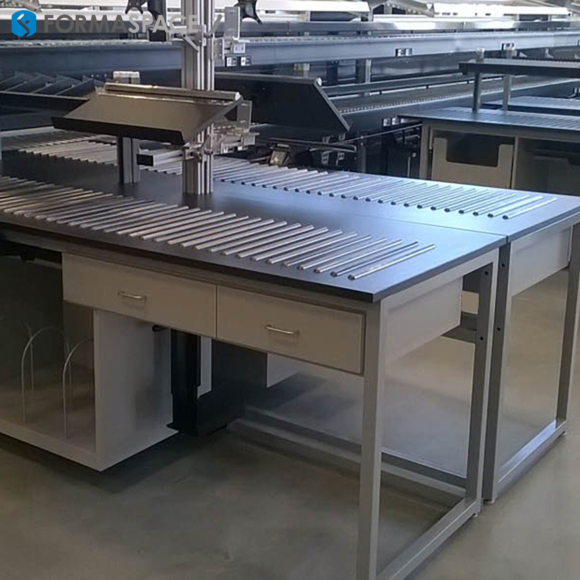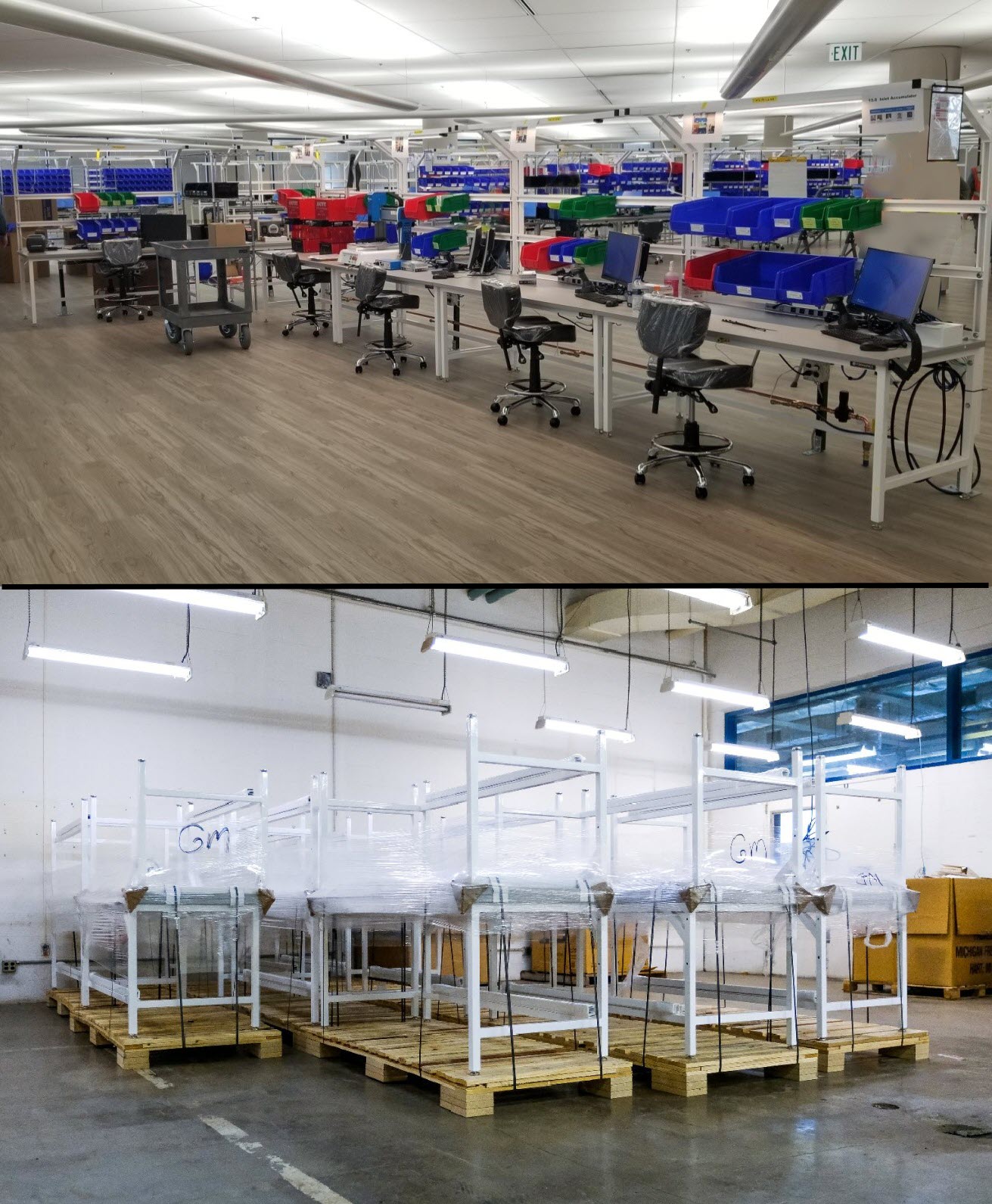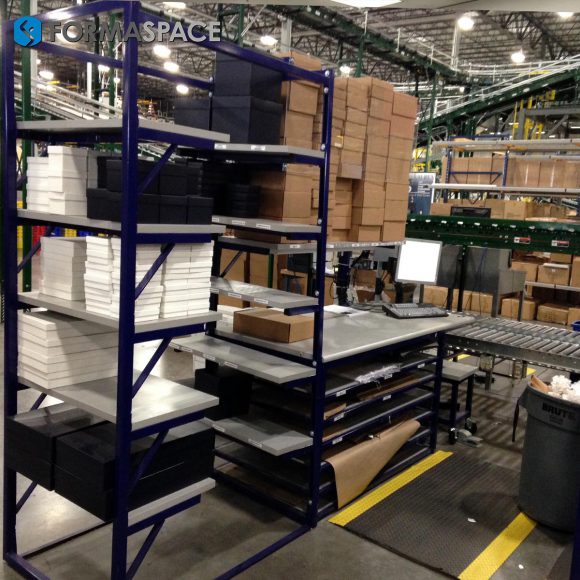For professional distribution center and warehousing managers, the COVID-19 pandemic has upended just about every rule in the book. The combination of business closures, radically changing consumer demand, supply chain interruptions, and transportation constraints mean it’s no longer possible to rely on time-honored best practices in logistics and material handling. We take a look at the unique challenges facing warehousing and distribution centers during these difficult times and how the industry is changing as a result.
COVID-19 has created the perfect storm for the warehousing and distribution center industry.
With millions of workers staying at home and countless business closing their doors around the country, the demand for home deliveries has shot through the roof, while orders for the travel, hospitality, and food service industries have fallen through the floor. Meanwhile, dangerous shortages of urgently needed medical equipment persist, putting both medical professionals and patients at risk.
Let’s take a look at several different market sectors, starting with the urgent efforts to distribute medical supplies, to see how the new reality for warehousing and distribution centers is shaping up on the ground — and in the air.
The Rush to Distribute Much Needed Medical Supplies
For distribution center and warehousing professionals seeking order and efficiency, the frenetic state of today’s medical distribution market has been anything but.
Accusations of hoarding, price gouging, fake/fraudulent or defective products — and even piracy — have been bandied about as the federal government, states, cities, and hospital systems have competed with one another (and similar organizations in other countries) to secure an adequate supply of PPE (including masks, gowns, faced shields, sanitizer gels) and critical care ventilators for COVID-19 ICU patients.
In response, Amazon has limited purchases of critical medical gear to hospitals and health care providers. And to speed up delivery from its distribution centers, it has temporarily cut back on deliveries of non-essential products in certain markets, as well as temporarily restricting transactions for inventory sold by some of its third-party sellers.
Fox affiliate KTBC Channel 7 interviews Formaspace CEO Jeff Turk on the company’s efforts to manufacture 500 new workbenches to support General Motors’ quick efforts to start ventilator production in Kokomo, Indiana. Formaspace built and shipped their first truckload of workbenches to GM’s facility just three days after receiving the order.
Meanwhile, supply chain procurement specialists have been going to extreme lengths to cut through the waves of fraud and profiteering middlemen that have popped up to take advantage of the situation. According to one Bloomberg report, legitimate purchasing agents are even resorting to using coded phrases inside their communications with suppliers to verify identities and fight against fraud. (Now would be a good time for some of those long-promised blockchain-based supply chain verification systems—just saying 😛 ) This practice extends to using coded phrases in videos of factory production, which purchasers are relying on more and more as most on-site factory visits are generally prohibited.
Some of the more well connected Amazon resellers are using their supply chain connections to deliver for PPE to the USA from China and other countries.
As these goods are received assembled, government officials are taking measures reminiscent of hurricane recovery. Ad hoc distribution centers have been hastily set up in sports arenas in two Florida cities (Orlando and Daytona Beach) as well as in Chicago.
Meanwhile, domestic production of PPE is ramping up. 3M has dramatically increased its production of the sought after N95 masks (so-called as they filter out 95% of 3-micron particles and above). GM and Ford have also begun domestic production of much-needed ventilators.
Formaspace has been a part GM’s quick efforts to start ventilator production in Kokomo, Indiana. We built and shipped our first truckload of 500 new workbenches from our factory in Austin, Texas, to GM’s facility just three days after receiving the order. GM was able to initiate production of its first ventilator after 11 days.
More changes are sure to follow.
Indeed, the COVID-19 experience to date has convinced many government policymakers and healthcare professionals of the need to ensure adequate production capacity of medical supplies (including medicines) here in the USA to avoid a repeat of this need to scramble for overseas production again in the future.
Electronic Components Market Recovers Some Ground as Asian Cargo Rebounds
Things may be returning to a more normal state in the electronics market.
The Asian electronics manufacturing industry was one of the first to suffer massive disruption due to the COVID-19 pandemic.
Critical factories making everything from semiconductors to assembling Apple iPhones were shut down across China and South Korea during the early phase of the pandemic, disrupting just-in-time supply chains for consumer electronics and compounds alike.
But, as China, South Korea, and Taiwan have been able to reopen factories and resume production (albeit at a reduced capacity), the supply chain in electronics goods is expected to recover.
Evidence supporting this includes FedEx’s decision to return some of its previously mothballed cargo jets back into service as well as industry insiders who point to important product introductions scheduled for later this year, including a new generation of Apple iPhones.
Major Distribution Centers Shut Down as Retailers Forced to Close their Doors
If the electronics market represents the light at the end of the tunnel, it’s still lights out for much of the traditional bricks and mortar retail market.
Retailers with a heavy dependence on physical traffic have been particularly hard hit, as the majority have been classified as ‘non-essential’ businesses, and thus have been obliged to close their doors as part of the “stay at home” orders issued across much of the country.
With their traditional retail outlets closed, many major names in the retail industry have tried to juice up their online sales.
Unfortunately, quite a few have been forced to lay off a significant portion of their workforce or even shut down their warehouse and distribution operations completely for an unknown period of time.

These include TJX (parent company of TJ Maxx and Marshalls), Under Armour, Guitar Center, Burlington Stores (formerly Burlington Coat Factory), and Newell Brands’ Yankee Candle.
Distribution Centers Struggle to Satisfy the Needs of Millions Complying with Stay at Home Orders
Record-setting home broadband and WISP (phone) Internet usage is just one way to confirm what we all know from our personal experience — consumers stuck at home have been turning to online entertainment (apps sales are at an all-time high), video conferencing (for work and to socialize with friends), and e-commerce (home delivery of consumer goods, especially groceries and restaurant meals) in record numbers.
This sudden shift in inventory demand away from restaurants, hospitality, travel, and educational institutions to home consumers has led to some unique improvising across the supply chain.
For example, to meet the shortage of toilet paper in homes, warehousing and distribution center professionals have had to break apart pallets of commercial rolls of toilet paper shipments to apply individual UPC stickers on each item so they can be scanned for purchase at retail store cash registers.
In some cases, companies are establishing quotas to manage demand. Amazon recently announced a waitlist for new customers using their home grocery delivery service.
Yes, it’s a boom right now for groceries and other home products.
But there are concerns among distributors that, once the panic buying subsides, consumer purchases alone won’t be able to make up for the lost business from closed restaurants and other commercial food service operators.
Disruptions in the Transportation System Causing Distribution Center Delays
Transportation logistics – or the lack thereof – has become another major headache for Distribution Center professionals.
As the supply chain readjusts to the new demands placed on it during the COVID-19 pandemic, many warehouses and distribution centers are having trouble managing efficient shipping logistics. In some cases, facilities are unable to keep up with increased demand, leaving truckers parked in long lines that can last for hours or even days as they wait to pick up or drop off a load.
Long lines are not the only obstacle facing the nation’s truckers. Many are finding it difficult or impossible to find places on the road to eat, shower, or even use the bathroom, as officials order restaurants and other facilities closed. Long hours are the norm at the moment; the Federal Motor Carrier Safety Administration has temporarily waived rules on how many hours truckers can work.
We mentioned earlier that air cargo shipments servicing Asia have picked up, but overall, air cargo is operating a skeleton force now that the airlines have pulled back so many passenger flights. When flights are canceled, so too are the shipments that normally fly in the cargo hold in the belly of the plane.) To make up for the shortfall, some carriers are increasing cargo-only flights; American Airlines recently flew its first all-cargo flight since before World War II.

Most international express package delivery has slowed to a crawl. For example, Australia Post reports that individual express packages are experiencing delays of 2 – 3 weeks or to reach destinations in the USA.
Interestingly, Amazon has elected to close down its own shipping company, a venture it set up recently to compete with UPS and FedEx in certain markets.
And if that wasn’t enough, the USPS is at risk of going bankrupt unless Congress steps in to provide a bailout or allow it to expand operations outside its narrow guidelines.
Distribution Centers and Warehouses Are Offering Increased Wages and Bonuses to Attract New Workers
Demand for new employees to handle the surge for home is one bright spot in a dismal employment market.
In recent weeks, Amazon has hired about 100,000 new workers and is advertising for 75,000 more.
Hourly wages and incentive bonuses are on the rise as well. Home Depot is recruiting 200 workers for its McCalla, Alabama Distribution Center, with offers of $50 – $100 weekly bonuses and double overtime pay.
Food distributors, such as Food Lion, are also raising wages to meet the rising demand for home deliveries and grocery store purchases as consumers prepare meals at home.
New Warehouse and Distribution Center Projects Opening Up or Breaking Ground
Meanwhile, there are urgent efforts to expand warehouse and distribution center capacity.
That’s because many facilities are operating at full capacity, such as the Kroger Distribution Center in Louisville, Kentucky.
Several construction projects that were underway before the pandemic have been sped to completion, including the new 700,000 sq ft Lidl Distribution Center in Cecil County, Maryland and the new Kroger Distribution Center in south Dallas.
And plans for new facilities are moving forward. For example, Amazon just inked a deal for 80 acres in Little Rock, Arkansas, and Madison, Wisconsin’s City Council approved plans for a new Amazon Distribution Center on the east side of town.

Increased Hygiene and Other Health Measures Designed to Help Keep Distribution Center Workers Safe
The increased workload at distribution centers across the country has not been without tragedy.
All across the country, there have been reports of individual workers falling ill from COVID -19, with nearly all of the major warehousing and distribution companies reporting at least one incident of illness and, in some cases, loss of life.
What measures can the industry take to ensure the health of its workforce?
Industry experts point to several best practices, including:
- Wearing PPE, including face shields and masks on the job.
- Stepping up sanitation efforts to clean all commonly touched surfaces multiple times a day using CDC-approved cleaning materials.
- Changing the warehouse and distribution facility layouts (including packing stations and work table configurations) to maintain social distancing between workers.
- Staggering work shifts to reduce the concentration of workers on site at any one time, as well as staggering break times, to limit the number of workers using break rooms, kitchen messes, and bathroom facilities at one time.
For more tips, read our interview with Formaspace Production Manager Mike Bush, who explains in detail what steps Formaspace takes to keep its production team safe.
(EDITOR NOTE link to article)
How Will COVID-19 Reshape the Future of the Warehousing and Distribution Center Industry?
Industry analysts believe that the warehousing and distribution center business will be forever changed by this epidemic, long after things “return to normal.”
EDITOR NOTE insert art https://formaspace.com/workbench-gallery/material-handling/packing-station-with-scale-cut-out/
Formaspace manufactured these custom linear flow workbenches, which feature a built-in scale cut-out at right.
We can expect major changes to facility layouts, including revisions to packing stations and workstations, to increase the distance between workers, just to be “safe.”
Unfortunately for retailers who are overly reliant on physical “bricks-and-mortar” stores, the sudden shift to online shopping may become somewhat permanent, ultimately accelerating a trend town e-commerce that was already well underway before the advent of the pandemic.
But one of the most consequential changes for the warehousing and distribution center industry will be increased automation.
Take Kroger, for example. The newly opened Kroger facility in south Dallas (mentioned above) has been in the works for several years. The new facility uses robots (created in partnership with the UK-based Ocado online grocery store) that can fill a 50-item order in less than 10 minutes. Kroger recently announced it will build another 350,000 square-foot robotic Customer Fulfillment Center in Frederick County, Maryland, also using the Ocado robot technology.
EDITOR NOTE insert art https://formaspace.com/workbench-gallery/custom-workbenches/patented-robot-highway-furniture/
In this project, our Technical Sales team collaborated with the client’s project managers to create a furniture system that integrates with robotic pickers to create a dedicated “robot roadway” within the distribution center.
We can also see the day when robot-based delivery systems will become commonplace.
Starship Technologies, a British startup, has deployed its miniature autonomous vehicles during the pandemic lockdown to bring food deliveries to residents in Milton Keynes, a postwar town located mid-way between London and Birmingham.
Formaspace is Your Warehousing and Distribution Center Partner
During these difficult times, you can depend on Formaspace.
We are operating at full capacity, with extra shifts, to ensure that we can deliver custom furniture to meet your urgent deadlines.
Take the next step.
Talk to your Formaspace Design consultant, and find out how we can work together to upgrade your current warehouse or distribution center to meet today’s changing needs, or create efficient new facilities to meet the demands of today and tomorrow.
















